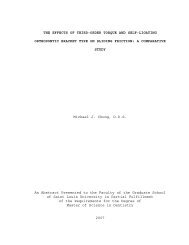Celebrating Father Biondi's Anniversary - Saint Louis University
Celebrating Father Biondi's Anniversary - Saint Louis University
Celebrating Father Biondi's Anniversary - Saint Louis University
You also want an ePaper? Increase the reach of your titles
YUMPU automatically turns print PDFs into web optimized ePapers that Google loves.
MiCrOFiLM reADerS in SLU’S VATiCAn FiLM LibrAry<br />
SCHolARly SCRAmble<br />
When the Vatican Library in rome<br />
announced during the summer that it<br />
was closing for a three-year renovation,<br />
scholars panicked at the prospect of being cut<br />
off from their crucial research sources.<br />
The Vatican apologized for the short notice, but<br />
it said the decision was unavoidable. The wing<br />
of the 16th-century building where the library<br />
and reading rooms are located is sagging due<br />
to age and the sheer weight of the books and<br />
manuscripts.<br />
Luckily for scholars and for <strong>Saint</strong> <strong>Louis</strong><br />
<strong>University</strong>, about half of the Vatican Library’s<br />
collection is on microfilm in the <strong>University</strong>’s<br />
Vatican Film Library (VFL). Ambrogio Piazzoni,<br />
vice prefect of the Vatican Library in rome, said<br />
he is referring scholars to <strong>Saint</strong> <strong>Louis</strong> <strong>University</strong><br />
to pursue their research during the shutdown.<br />
“A lot of people plan their research agenda<br />
several years in advance,” said Dr. Thomas<br />
Madden, director of SLU’s Center for Medieval<br />
and renaissance Studies. “if they’re applying<br />
for grants or students are writing dissertations<br />
that require documents found in rome and the<br />
materials are no longer available to them, the<br />
only other place in the world where they are<br />
available is here at SLU.”<br />
Dr. gregory Pass, director of the VFL, said he<br />
already has had a number of inquiries from<br />
researchers who had planned to study at the<br />
Vatican and needed to rearrange their plans.<br />
He said applications for VFL fellowships are<br />
up noticeably, and efforts are under way to<br />
increase the number of fellowships offered to<br />
accommodate additional scholars. Pass and the<br />
staff of the VFL are preparing for the anticipated<br />
influx of scholars by making the collection more<br />
accessible and by expanding its Web site.<br />
“This is a wonderful opportunity for us to draw<br />
greater attention to our collection and to seek<br />
outside funding that could help us add to our<br />
already significant holdings,” Pass said.<br />
{captions}<br />
Gavitt said he soon realized that Special Collections could be a wonderful teaching tool as<br />
well. He regularly brings his students to the library for tours and lectures to help them appreciate<br />
the importance of using primary sources in research.<br />
“It amazes students to have these books at their fingertips,” he said. “When they touch a<br />
piece of animal skin that someone wrote on more than 600 years ago, there’s a sense of awe. It<br />
awakens them from their dogmatic slumber and inspires fresh thought.<br />
“I also believe that it’s one thing for students to read what historians have said about a<br />
particular work, but to see that original work and to interpret it for themselves teaches critical<br />
thinking in a way nothing else can.”<br />
Treasures in Microfilm<br />
Rare books and manuscripts are only one part of Special Collections. The department also<br />
includes the <strong>University</strong> Archives, which serves as SLU’s memory — documenting its history<br />
from before its founding in 1818 to the present with a wide variety of materials including official<br />
records, photographs, publications and personal papers (notably the archives of the late<br />
<strong>University</strong> Professor Walter J. Ong, S.J.).<br />
Also under the Special Collections umbrella is the Knights of Columbus Vatican Film Library<br />
(VFL), an unparalleled resource for scholars in the United States.<br />
The roots of the VFL go back to the early 1950s, when Lowrie J. Daly, S.J., then a 37-yearold<br />
associate professor of medieval history, proposed the <strong>University</strong> seek permission to make<br />
microfilm copies of rare and ancient manuscripts in the Biblioteca Apostolica Vaticana (Vatican<br />
Library) in Rome to facilitate research by scholars in the Western hemisphere.<br />
The Vatican Library possesses one of the most important collections of Medieval and Renaissance<br />
manuscripts in the world — containing some 75,000 codices representing just about<br />
every aspect of the Western European intellectual and artistic experience.<br />
Pope Pius XII granted permission for the project. And, with generous financial support from<br />
the Knights of Columbus, Daly headed to Rome. He oversaw a team of Italian technicians as<br />
they captured thousands of high-quality images of the manuscripts.<br />
Nearly every month from 1951 to 1957, the team sent back to SLU microfilm reels containing<br />
roughly 1,000 manuscripts.<br />
“It was a remarkable project,” Pass said. “Before this time, microfilm was limited largely to<br />
military or industrial purposes. The impact of using microfilm on such a large scale for this<br />
project, capturing 12 million manuscript pages, was in some ways comparable to the application<br />
of computing technology to the humanities over the past 10 to 15 years.”<br />
Big Draw<br />
{on page 16} Llangattock Breviary (Ferrara, 1441–48), St. <strong>Louis</strong>, <strong>Saint</strong> <strong>Louis</strong><br />
<strong>University</strong> Library, MS 2e<br />
{a} {B} {C}<br />
When the VFL opened in 1953 in DuBourg Hall, scholars traveled from throughout the world<br />
to see the microfilmed treasures. They still do.<br />
“We often have European scholars visiting, even some from Italy, who find it easier to work<br />
with our resources than with the originals in the Vatican Library. This is partly because of the<br />
high demand on the Vatican Library’s limited reading space, but also because of the limited<br />
{a} Aegidius gutbier, Novum domini nostri Jesu Christi Testamentum Syriacè<br />
(Hamburg, 1664), bound with Lexicon Syriacum (Hamburg, 1667) and<br />
Notae criticae in Novum Testamentum (Hamburg, 1667)<br />
number of manuscripts that scholars are allowed to consult in a single day,” Pass said. “We’re<br />
preparing for an even greater influx of scholars with the temporary closing of the Vatican Library<br />
in Rome.” (See sidebar on page 18.)<br />
The VFL is unique to SLU and was the catalyst for construction of Pius XII Memorial Library.<br />
Although the initial microfilming project ended in 1957, the VFL did not stop acquiring<br />
material. It continues to assemble a comprehensive reference collection of books, serials, microforms,<br />
electronic materials and other media in all areas of manuscript studies — illumination,<br />
paleography, codicology, book production, library history, etc. It now has more than 37,000<br />
manuscripts on microfilm — slightly better than half of the Vatican’s collection.<br />
Among the most significant holdings are:<br />
Codex Vaticanus, one of the oldest surviving manuscripts of the Bible written in Greek sometime<br />
during the middle of the 4th century.<br />
Vergilius Romanus (The Roman Virgil), produced between the 5th and 6th centuries. It is<br />
one of the oldest surviving copies of the works of Virgil and one of few surviving examples<br />
of Roman miniature painting.<br />
Commentaries written in the hand of St. Thomas Aquinas.<br />
Poetry written in the hand of Petrarch, the famous Italian scholar, poet and Renaissance<br />
humanist.<br />
Sunspot observations by Galileo.<br />
Greater Access<br />
The VFL hosts a fellowship program (another is offered by SLU’s Center for Medieval and Renaissance<br />
Studies) and an annual manuscripts conference to help achieve its mission of making<br />
its abundant resources available to scholars. For the past 50 years, it has edited and published<br />
Manuscripta, a scholarly journal devoted to research on medieval and Renaissance manuscripts.<br />
It is the only journal of its kind in North America.<br />
Two years ago, Special Collections hired its first rare book cataloguer to make the collections<br />
more accessible through rare book records input as part of the <strong>University</strong> libraries’ online catalogue.<br />
As a result, the number of rare book queries from researchers worldwide has increased<br />
substantially. The recent addition of a rare books librarian will further expand knowledge of<br />
the collections and the ability to assist patrons.<br />
All of this activity fits with the <strong>University</strong> libraries’ ambitious five-year strategic plan,<br />
which includes for Special Collections expanding its reading room, creating climate-controlled<br />
storage areas, increasing acquisitions budgets and providing digital access to its<br />
materials. But while digitization allows wider access, <strong>University</strong> Archivist John Waide believes<br />
that nothing beats the real thing.<br />
“Vision is just one of our senses,” said Waide, as he holds a journal handwritten in the 1850s<br />
by Pierre-Jean DeSmet, S.J. “We also have touch and smell. Holding this book is a total sensory<br />
experience. I’m not the first reader. I’m sharing it with someone who lived 100 years before me.<br />
You can’t fully appreciate that unless you hold the book in your hands. These are true treasures<br />
on our campus.”<br />
meSSAge fRom HiS HolineSS pope piuS Xii<br />
January 2, 1953<br />
To Our beloved Son<br />
Paul C. reinert, S. J.<br />
President of <strong>Saint</strong> <strong>Louis</strong> <strong>University</strong><br />
it is with sincere pleasure that We reply to<br />
your letter, beloved son, thanking Us for the<br />
extraordinary permission granted to <strong>Saint</strong><br />
<strong>Louis</strong> <strong>University</strong>, of which you are the worthy<br />
President, to make microfilm copies of extensive<br />
portions of the Vatican Library. With pleasure,<br />
We say, because We are gratified to learn<br />
from your letter of your further plan that these<br />
priceless treasures, the wealth of centuries of<br />
scholarship and learning, are to find a fitting<br />
home in a new and ample university library,<br />
which will thus become a center for scholars<br />
throughout your vast land. Such a plan strikes<br />
a sympathetic chord in Our own heart, intent as<br />
We are, and as the Church has always been, on<br />
fostering knowledge and wisdom.<br />
Heartily then do We approve your plan,<br />
beloved son, with the hope that you and<br />
your colleagues will find many who are ready<br />
and eager to co-operate in an enterprise<br />
so advantageous to the cause of Catholic<br />
culture in America. We are happy to note that<br />
Our beloved sons, the knights of Columbus,<br />
have generously made possible an important<br />
step towards the realization of your plan, by<br />
defraying the expenses of the microfilming. May<br />
this be a bright omen of the final and happy<br />
consummation of your dream, a university<br />
library which will be a spacious temple of<br />
learning, a storehouse of the good, the true, the<br />
beautiful. Willingly then do We accede to your<br />
filial request that this new library be designated<br />
the “Pius Xii Memorial Library.”<br />
As an earnest of abundant heavenly blessings<br />
on this important work, We impart to you,<br />
beloved son, to your benefactors, your faculty<br />
and your students, the Apostolic benediction.<br />
{B} Athanasius kircher, China Monumentis (Antwerp, 1667), frontispiece {C} Mark Twain, Adventures of Huckleberry Finn (new york: Charles L. Webster<br />
and Company, 1885)<br />
18 UNIVERSITAS www.slu.edu UNIVERSITAS FALL 2007 19
















